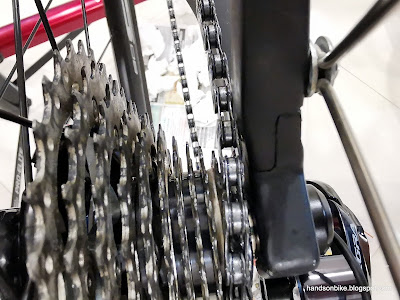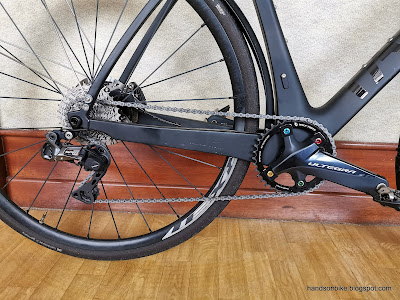While changing the drivetrain on the Fabike C3 from a belt drive to a chain drive, I found some issues with the shifting performance. More specifically, when shifting outwards from the 12T to the 11T sprocket, which is the top gear.
I was using the Ultegra Di2 RD-6870, which was a modified version with a short cage. This rear derailleur has a construction that can support up to a 32T max sprocket, but with a short cage for more ground clearance with small wheels. So, it should actually match well with the 11-32T cassette used on this setup.
However, the distance between the guide pulley and the gear sprocket seems to be rather big at the top few gears (11T and 12T), which could be the reason why the shifting does not occur smoothly. About 1 out of 5 times it will fail to shift properly.
I also noticed a metallic clinking sound when shifting from 11T to 12T. I could not find where it came from, until I looked from the top and saw the chain briefly touch the end of the bolt (for joining the split section of the frame) during shifting. During pedaling in either 12T or 11T, there is no interference. The touching only occurs during shifting, when the chain flexes as shown below.
When shifting from 11T to 12T, the chain will touch the inside of the bolt briefly.
Due to the flex of the chain, it will bend and touch the end of the bolt during shifting.
The touching is not a big issue, just something odd that I discovered. However, I was not happy with the shifting performance, as it would fail to shift about 1 out of 5 times. The other times the shifting was mostly delayed.
Therefore, I swapped in another rear derailleur to try and find the root cause. I took the Ultegra Di2 RD-R8050-SS from the Dahon MuSP, which is rated for up to 30T sprocket only. It is out of specifications, but no harm trying. It is easy to swap in a Di2 rear derailleur as there is no inner cable to fix and adjust.
What I found was that the performance was actually worse, as the chain will sometimes drop off from the top sprocket when shifting outwards from 12T to 11T. This was despite setting up the limit screws properly. The distance between the guide pulley and the 12T / 11T sprockets was quite big as well.
Chain drop from the top gear of the cassette, despite the limit screws being set properly.
At this point, I suspected that the dropout may not be made to the recommended specifications. On the Di2 rear derailleurs, I had to set the electronic position adjustment all the way inwards, in order to align the guide pulley to the gear sprockets correctly for shifting. This was because the resting surface on the dropout for the rear derailleur was too far outwards.
The dropout angle also looked a bit odd, as it seems to tilt back too much, which will also cause the big distance between the guide pulley and the sprocket. Before all the above installation and testing, I had already checked to make sure that the dropout was straight and not bent. However, I was unable to measure the actual dropout dimensions.
Recommended dropout dimensions by Shimano, for optimum shifting performance.
Without measuring the dropout dimensions, I cannot say for sure that the dropout is wrong, but I never had the same issues with the same rear derailleurs on other bikes.
I still had one Di2 rear derailleur to try, which is the GRX Di2 RD-RX817 rear derailleur. This is quite different from the previous two that I tried (Ultegra 6870 and R8050), as this GRX rear derailleur is front single specific, with a different construction.
As this GRX rear derailleur is meant for a front single drivetrain with a large sprocket size of 40T/42T, it is actually not designed to work with this 11-32T cassette that I have on the Fabike C3. However, my theory was that if the distance between the guide pulley and the smaller sprockets was too big (due to wrong dropout design), this wide range rear derailleur with a big slant angle will allow me to close up this distance.
RD-RX817 has a bigger slant angle, which will theoretically give a closer guide pulley to sprocket distance at the top gears (12T / 11T) if the B-tension is set to be the same at the large 32t sprocket.
Note that this component setup is not recommended (RD-RX817 with 11-32T cassette), if the dropout dimensions are correct. I am only trying this to compensate for the unusual dropout dimensions.
RD-RX817 on 11-32T cassette, at low gear
With the B-tension screw fully loosened, this is the closest I can set the guide pulley to the 32T sprocket. This is because this rear derailleur was designed for a low sprocket size of 40T /42T, not a much smaller 32T sprocket.
At the top gear position, on 11T sprocket
The distance between the guide pulley and the 11T sprocket is much closer than using the other rear derailleurs. Luckily there is enough frame clearance for a large cage with offset guide pulley.
View from the back
With this GRX rear derailleur, shifting performance is now very good! Although this setup is outside the recommended specifications, it works well for this particular bike. The clutch is a bonus, although not necessary.
Latest drivetrain setup, with a front 38T chain ring, rear 11-32T cassette, and GRX Di2 rear derailleur.
With all the accessories removed, except the mudguards. This is one fast commuting bike!
Final Di2 wiring layout. Basically everything is the same, except that I changed the Alfine 11 motor unit to the rear derailleur.
Full bike specifications, with a chain drive setup. Only 8.1 kg without pedals!
For comparison, the previous internal hub + belt drive setup was about 9.1 kg without pedals, so this is a big weight difference. From the very first Avanti Inc 3, there has been drastic weight savings for each iteration. All weights listed below are without pedals and mudguards.
Avanti Inc 3 Alfine 11 Di2 drop bar: 10.9 kg
Fabike C3 Alfine 11 Di2 drop bar: 9.1 kg
Fabike C3 Ultegra Di2 drop bar: 8.1 kg
Pedals will add about 400 grams, while mudguards will add about 500 grams.
There has been a big weight difference compared to the Avanti Inc 3, and it is a difference that can be felt when riding, and most importantly, when carrying the bike. Now it rides almost like a pure road bike, which is what I wanted: A road bike that I can ride in all-weather for commuting.














No comments:
Post a Comment
Every comment is moderated before publishing due to spam bots. If you don't see your comment yet, it is likely that it is currently being reviewed. Thank you for your patience!